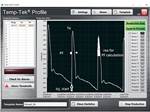INJECTION MOLDING: Infrared Sensors Measure ‘Real’ Melt Temperature
Mold-mounted fiber-optic sensors do what ordinary thermocouples can't.
A new solution to injection molders’ longstanding need for more effective melt-temperature monitoring is one of a range of process-monitoring products being introduced to the U.S. from Futaba of Japan (see also Close Up story in this issue). Futaba Corp. of America, Schaumburg, Ill., is offering the following:
• Melt-temperature sensors: The reportedly unique products in the lineup are fiber-optic
infrared (IR) sensors that directly sense the temperature of the melt. They come in long knockout-pin type versions (photo) or short flush-mount versions for installation in a mold flow path. Unlike thermocouple-type sensors (which Futaba also supplies), the IR type is not affected by the surrounding steel temperature, and it can sense the IR emissions of the melt even as the part cools and shrinks away from direct contact with the sensor.
Futaba says effective melt-temperature sensing gives molders insight into the combined effects of barrel heating and shear heating, and the measured cooling rate correlates with the degree of packing of the part. Thus, knowing the actual plastic temperature as the runner and part cool allows better decisions on injection speeds, pack pressures, mold temperatures, cooling time, and cycle time. Futaba sources also say melt-temperature sensing is useful for detecting end-of-fill in mold cavities, due to its fast (8 millisec) response rate. The IR melt sensor reportedly is being used in Japan by major customers such as Toyota, Nissan, Panasonic, and Denso.
• Cavity-pressure sensors: Futaba also markets standard strain-gauge sensors of knockout-pin or button type.
• Process monitors: Futaba’s Mold Monitoring System (MMS) is described as a “simple and smart” solution for cavity-pressure or melt-temperature monitoring. The eight-channel pressure amplifier is said to be simple to set up and run with very little training, and it reportedly sells for much less than competing systems. It can operate with a PC link or stand alone. Users can choose from eight parameters to make accept/reject decisions (peak pressure, area under the curve, etc.).
Related Content
-
Got Streaks or Black Specs? Here’s How to Find and Fix Them
Determining the source of streaking or contamination in your molded parts is a critical step in perfecting your purging procedures ultimately saving you time and money.
-
A Systematic Approach to Process Development
The path to a no-baby-sitting injection molding process is paved with data and can be found by following certain steps.
-
What to Look for in High-Speed Automation for Pipette Production
Automation is a must-have for molders of pipettes. Make sure your supplier provides assurances of throughput and output, manpower utilization, floor space consumption and payback period.















